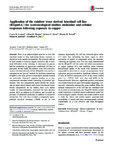Application of the rainbow trout derived intestinal cell line (RTgutGC) for ecotoxicological studies: molecular and cellular responses following exposure to copper
| dc.contributor.author | Langan, Laura | |
| dc.contributor.author | Harper, Glenn | |
| dc.contributor.author | Owen, SF | |
| dc.contributor.author | Purcell, WM | |
| dc.contributor.author | Jackson, SK | |
| dc.contributor.author | Jha, Awadhesh | |
| dc.date.accessioned | 2018-02-26T14:51:55Z | |
| dc.date.available | 2018-02-26T14:51:55Z | |
| dc.date.issued | 2017-10 | |
| dc.identifier.issn | 0963-9292 | |
| dc.identifier.issn | 1573-3017 | |
| dc.identifier.uri | http://hdl.handle.net/10026.1/10857 | |
| dc.description.abstract |
There is an acknowledged need for in vitro fish intestinal model to help understand dietary exposure to chemicals in the aquatic environment. The presence and use of such models is however largely restrictive due to technical difficulties in the culturing of enterocytes in general and the availability of appropriate established cell lines in particular. In this study, the rainbow trout (Oncorhynchus mykiss) intestinal derived cell line (RTgutGC) was used as a surrogate for the "gut sac" method. To facilitate comparison, RTgutGC cells were grown as monolayers (double-seeded) on permeable Transwell supports leading to a two-compartment intestinal model consisting of polarised epithelium. This two-compartment model divides the system into an upper apical (lumen) and a lower basolateral (portal blood) compartment. In our studies, these cells stained weakly for mucosubstances, expressed the tight junction protein ZO-1 in addition to E-cadherin and revealed the presence of polarised epithelium in addition to microvilli protrusions. The cells also revealed a comparable transepithelial electrical resistance (TEER) to the in vivo situation. Importantly, the cell line tolerated apical saline (1:1 ratio) thus mimicking the intact organ to allow assessment of uptake of compounds across the intestine. Following an exposure over 72 h, our study demonstrated that the RTgutGC cell line under sub-lethal concentrations of copper sulphate (Cu) and modified saline solutions demonstrated uptake of the metal with saturation levels comparable to short term ex situ gut sac preparations. Gene expression analysis revealed no significant influence of pH or time on mRNA expression levels of key stress related genes (i.e. CYP3A, GST, mtA, Pgp and SOD) in the Transwell model. However, significant positive correlations were found between all genes investigated suggesting a co-operative relationship amongst the genes studied. When the outlined characteristics of the cell line are combined with the division of compartments, the RTgutGC double seeded model represents a potential animal replacement model for ecotoxicological studies. Overall, this model could be used to study the effects and predict aquatic gastrointestinal permeability of metals and other environmentally relevant contaminants in a cost effective and high throughput manner. | |
| dc.format.extent | 1117-1133 | |
| dc.format.medium | Print-Electronic | |
| dc.language | en | |
| dc.language.iso | eng | |
| dc.publisher | Springer Science and Business Media LLC | |
| dc.subject | Ecotoxicology | |
| dc.subject | Animal replacement | |
| dc.subject | in vitro | |
| dc.subject | Rainbow trout | |
| dc.subject | RTgutGC | |
| dc.subject | Dietary | |
| dc.subject | Copper | |
| dc.title | Application of the rainbow trout derived intestinal cell line (RTgutGC) for ecotoxicological studies: molecular and cellular responses following exposure to copper | |
| dc.type | journal-article | |
| dc.type | Journal Article | |
| plymouth.author-url | https://www.webofscience.com/api/gateway?GWVersion=2&SrcApp=PARTNER_APP&SrcAuth=LinksAMR&KeyUT=WOS:000412308100010&DestLinkType=FullRecord&DestApp=ALL_WOS&UsrCustomerID=11bb513d99f797142bcfeffcc58ea008 | |
| plymouth.issue | 8 | |
| plymouth.volume | 26 | |
| plymouth.publication-status | Published | |
| plymouth.journal | Ecotoxicology | |
| dc.identifier.doi | 10.1007/s10646-017-1838-8 | |
| plymouth.organisational-group | /Plymouth | |
| plymouth.organisational-group | /Plymouth/Admin Group - REF | |
| plymouth.organisational-group | /Plymouth/Admin Group - REF/REF Admin Group - FoSE | |
| plymouth.organisational-group | /Plymouth/Faculty of Health | |
| plymouth.organisational-group | /Plymouth/Faculty of Health/School of Biomedical Sciences | |
| plymouth.organisational-group | /Plymouth/Faculty of Science and Engineering | |
| plymouth.organisational-group | /Plymouth/Faculty of Science and Engineering/School of Biological and Marine Sciences | |
| plymouth.organisational-group | /Plymouth/REF 2021 Researchers by UoA | |
| plymouth.organisational-group | /Plymouth/REF 2021 Researchers by UoA/UoA06 Agriculture, Veterinary and Food Science | |
| plymouth.organisational-group | /Plymouth/Research Groups | |
| plymouth.organisational-group | /Plymouth/Research Groups/Institute of Translational and Stratified Medicine (ITSMED) | |
| plymouth.organisational-group | /Plymouth/Research Groups/Institute of Translational and Stratified Medicine (ITSMED)/CBR | |
| plymouth.organisational-group | /Plymouth/Research Groups/Marine Institute | |
| plymouth.organisational-group | /Plymouth/Users by role | |
| plymouth.organisational-group | /Plymouth/Users by role/Academics | |
| plymouth.organisational-group | /Plymouth/Users by role/Researchers in ResearchFish submission | |
| dc.publisher.place | United States | |
| dcterms.dateAccepted | 2017-07-13 | |
| dc.identifier.eissn | 1573-3017 | |
| dc.rights.embargoperiod | Not known | |
| rioxxterms.versionofrecord | 10.1007/s10646-017-1838-8 | |
| rioxxterms.licenseref.uri | http://www.rioxx.net/licenses/all-rights-reserved | |
| rioxxterms.licenseref.startdate | 2017-10 | |
| rioxxterms.type | Journal Article/Review | |
| plymouth.funder | Moving up a dimension: 3D in vitro models as effective alternatives to live fish studies::BBSRC |


